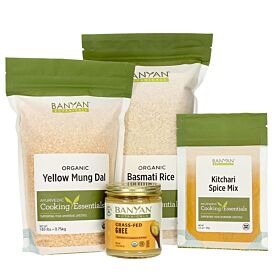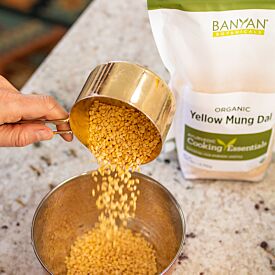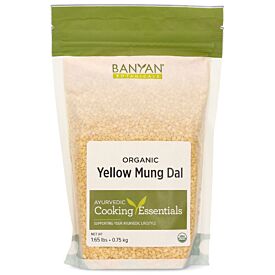A Beginner’s Guide to Spring Cleansing
Traditionally, when we think of spring cleaning, we think of our homes. But what about taking time to clean the accumulated toxins in our minds and bodies? If you find yourself feeling sluggish, bloated, experiencing brain fog, or you have an overall sense of lethargy, then it is time to clean and polish your body, mind, and spirit.
Over the years of guiding seasonal cleanses, I have found a few easy overarching tips to ensure a successful cleansing experience, and I’m here to share them with you.
Cleansing Basics
Ayurveda is a holistic science that encompasses the entirety of our lives, and this holistic approach is carried into a cleanse. Following this idea, a cleanse will not just focus on the food we consume but also what our senses take in.
Ayurveda recommends intentionally cleansing at specific times of year. Cleansing in the summer and winter months are not the most ideal times—the weather is typically more intense and our systems may be working harder simply to stay balanced.
Cleansing in the spring and fall seasons, however, are ideal times: these times of transition work naturally with our bodies’ willingness to shed the accumulated toxins (ama) and to ultimately clean out that which no longer serves us.
As we enter the spring season, we may still feel the lingering effects of rushed travel and never-ending festivities of the holiday season. This is the perfect time to take advantage of Mother Nature’s support and our bodies’ willingness to slow down.
The following tips will help you stay on course so you can experience a successful cleanse.
Plan Out Your Calendar
The very first thing to do is to look at your calendar, determine how many days your cleanse will last, and when to schedule your cleanse. If this is your first time, a three or nine day cleanse is a great place to start.
Carve out this time to spend on you, your cleansing experience, and your healing process.
Choose a practical time. If you know you have finals—don’t start your cleanse. If your best friend is getting married—don’t start your cleanse. If you know you have a business trip—don’t start your cleanse.
What you are doing is big. I have observed folks have a less-than-optimal experience due to maintaining a regular busy schedule while trying to fully detoxify.
We often need the respite a cleanse provides precisely because of our lifestyle and busy schedules. Let your family and friends know that you are not available during this time. They will most likely be supportive, interested, and encouraged by you taking the time to care for yourself.
You don’t need to become a hermit, and remember, everyone and everything will be there when you have finished (even coffee!).

Plan Your Meals for Every Step of the Journey
The next big tip: Plan your menu for your entire cleanse. An Ayurvedic cleanse is divided into three distinct phases—elimination, monodiet (which is the active cleansing phase), and reintroduction. When planning your menu, focus on foods that will support these phases.
Elimination Phase: Clean Up and Simplify Your Meals
In the first few days, you will eliminate potentially aggravating and hard-to-digest foods, like meats, cheese, and other types of dairy, wheat, sugar, caffeine, eggs, and alcohol. You will also want to eliminate foods that you find yourself attached to.
Take a moment to notice if you feel resistant to cleansing because you are asked to not consume a specific item. If you think you absolutely cannot live without coffee, then this might be an indication to eliminate it from your diet for a bit. You will survive. More importantly, take notice of how you feel once it is out of your system.
Think of this as a sugar-free, gluten-free, vegan diet, except for using some ghee. Focus on eating foods that are easy to digest, such as lightly steamed or sautéed vegetables, rice porridge, and puréed soups.
The first-of-the-season fruits and vegetables, like sprouts, dandelion greens, artichokes, and asparagus, are all available at the farmer’s market in the spring. These are perfect foods to support an effective cleanse as they scrub and detoxify the tissues of the body and have a clarifying effect on the mind.
It is very important to only eat when agni (the digestive fire) is strong and ready to consume the food it is given. Many times, when we think we are hungry, we are either bored or are just habitually or emotionally eating.
Not snacking between meals is critical during your cleanse, and also a great practice to continue after the cleanse has come to an end.
Try sipping Detox Digest or CCF Tea during the day. These detoxifying teas will hydrate your body, support your digestion, and help you avoid habitual snacking. If you are a coffee lover, enjoy a caffeine-free herbal coffee alternative like Bitter & Bold.
Active Cleansing Phase: Embrace a Monodiet
The middle of your cleanse is when most of the work is done. Being on a single-food diet for a few days will reset your digestion process.
Your meals will be a monodiet of kitchari. Kitchari is an easily digestible dish made of yellow split mung dal, basmati rice, ghee, and digestive spices, and often embellished with cooked vegetables.
The mix of the dal and rice makes a complete protein to give you energy and maintain a normal blood sugar balance. Adding plenty of vegetables will provide the fiber needed to assist the cleansing process.
Reintroduction Phase: Begin to Incorporate More Variety in Your Diet
The last step of the cleanse is to slowly return to eating regular foods by beginning with the meals you cooked when you were cleaning up your diet. Start with a simple menu for a couple days, then broaden your intake.
As you slowly reintroduce other foods back into your diet, notice if you have any uncomfortable experiences, which may show up as bloating, gas, nausea, a foggy mind, or even issues with the skin.
If this occurs, simply remove the food again and give your digestive tract time to recover. Decide if you want to try the food at a later date or not. I have had clients realize they have a food sensitivity during this final part of the process.
You will become very aware of your relationship with food during an Ayurvedic cleanse and as a result, you will naturally become more mindful of everything to do with food.
Take time to notice textures as you prepare your meals. Be aware of the flavors, aromas, and consistency of the dish that you are enjoying. Feel how your body interacts with the food you are eating. All of this will bring you into the present moment. Mindful eating is an important discipline we can practice whenever food is in front of us.

Nourish Yourself with a Supportive Daily Routine
The final tip to a successful cleanse does not have to do with food. Detoxifying and rebuilding the body goes much further than what we eat. Ayurveda teaches that there are daily practices that have an ongoing effect of purifying both the mind and the tissues of the body.
Dinacharya, or daily routine, is all about daily self-care rituals that benefit the body, mind, and spirit well beyond cleansing.
If you do not regularly treat yourself to a supportive dinacharya, now is a great time to start. Some examples of what can be incorporated into your daily routine are abhyanga (Ayurvedic self-massage), meditation, pranayama, yoga, and living in harmony with the rhythm of nature from day to day and season to season.
After the Cleanse
Once you have completed your cleanse, consider lightly treading the same path as a new commitment. Choose one day a week to have a mono-diet of kitchari. This will give your digestive system a rest and help maintain your agni. Eat your meals mindfully.
Eventually, you may even look forward to the changing of the seasons and your biannual Ayurvedic cleanse with excitement and anticipation. Happy cleansing my friends—I hope the restored you is full of radiance and bliss.














